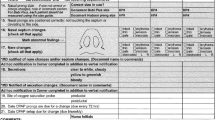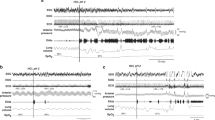Abstract
Objective:
Feeding neonates orally while on nasal continuous positive airway pressure (nCPAP) is a common practice. We hypothesize that pressurized airflow provided by nCPAP will alter the swallowing mechanism in neonates, increasing the risk of aspiration during oral feeding.
Study Design:
Infants receiving nCPAP with a RAM cannula and tolerating at least 50% of their feeding orally were included in the study (one term; six preterm infants). Each participant underwent a videofluoroscopic swallow study while on nCPAP and off nCPAP. A non-parametric signed-rank test was used for paired data.
Result:
The incidence of deep penetration (P=0.03) and aspiration (P=0.01) decreased significantly off-nCPAP compared with on-nCPAP. However, the incidence of mild penetration (P=0.65) and nasopharyngeal reflux (P=0.87) remained the same under both conditions.
Conclusion:
Oral feeding while on-nCPAP significantly increases the risk of laryngeal penetration and tracheal aspiration events. We recommend caution when initiating oral feedings on nCPAP.
This is a preview of subscription content, access via your institution
Access options
Subscribe to this journal
Receive 12 print issues and online access
$259.00 per year
only $21.58 per issue
Buy this article
- Purchase on SpringerLink
- Instant access to full article PDF
Prices may be subject to local taxes which are calculated during checkout



Similar content being viewed by others
References
Mahmoud RA, Roehr CC, Schmalisch G . Current methods of non-invasive ventilatory support for neonates. Paediatr Respir Rev 2011; 12: 196–205.
Sankaran K, Adegbite M . Non invasive respiratory support in neonates: a brief review. Chinese J Contemp Pediatr 2012; 14 (9): 643–665.
Gaon P, Lee S, Hannan S, Ingram D, Milner AD . Assessment of effect of nasal continuous positive pressure on laryngeal opening using fiber optic laryngoscopy. Arch Dis Child 1999; 80: F230–F232.
Nishino T, Sugimori K, Kohchi A, Hiraga K . Nasal constant positive airway pressure inhibits the swallowing reflex. Am Rev Respir Dis 1989; 140: 1290–1293.
Shaker CS . Nipple feeding preterm infants: an individualized, developmentally supportive approach. Neonatal Netw 1999; 18 (3): 15–22.
Shaker CS . Cue-based co-regulated feeding in the neonatal intensive care unit: supporting parents in learning to feed their preterm infant. Newborn Infant Nurs Rev 2013; 13 (1): 51–55.
Thoyre SM, Shaker CS, Pridham K . The early feeding skills assessment for preterm infants. Neonatal Netw 2004; 24 (3): 7–16.
Iyer NP, Chatburn R . Evaluation of a nasal cannula in noninvasive ventilation using a lung simulator. Respir Care 2015; 60 (4): 508–512.
De Paoli AG, Morley C, Davis P, Lau R, Hingeley E . In vitro comparison of nasal continuous positive airway pressure devices for neonates. Arch Dis Child Fetal Neonatal Ed 2002; 87 (1): F42–F45.
Fink TA, Ross JB . Are we testing a true thin liquid? Dysphagia 2009; 24 (3): 285–289.
Lee JH, Chang YS, Yoo HS, Ahn SY, Seo HJ, Choi SH et al. Swallowing dysfunction in very low birth weight infants with oral feeding desaturation. World J Pediatr 2011; 7 (4): 337–343.
Seluk B, Uysal H, Aydogdu I, Akyuz M, Ertekin C . Effect of temperature on electrophysiological parameters of swallowing. J Rehabil Res Dev 2007; 44 (3): 373.
Rogers R, Arvedson J . Assessment of infant oral sensorimotor and swallowing function. Ment Retard Dev Disabil Res Rev 2005; 11 (1): 74–82.
Newman LA, Keckley C, Petersen MC, Hamner A . Swallowing function and medical diagnoses in infants suspected of dysphagia. Pediatrics 2001; 108 (6): e106.
Tutor JD, Gosa MM . Dysphagia and aspiration in children. Pediatr Pulmonol 2012; 47 (4): 321–337.
Breton S, Steinwender S . Timing introduction and transition to oral feeding in preterm infants: current trends and practice. Newborn Infant Nurs Rev 2008; 8 (3): 153–159.
Simpson C, Schanler RJ, Lau C . Early introduction of oral feeding in preterm infants. Pediatrics 2002; 110 (3): 517–522.
Hanin M, Nuthakki S, Malkar MB, Jadcherla SR . Safety and efficacy of oral feeding in infants with BPD on nasal CPAP. Dysphagia 2015; 30 (2): 121–127.
Hu X, Lee JS, Pianoso PT, Ryu JH . Aspiration-related pulmonary syndromes. Chest 2015; 147 (3): 815–823.
Radford PJ, Stillwell PC, Blue B, Hertel G . Aspiration complicating bronchopulmonary dysplasia. Chest 1995; 107 (1): 185–188.
Boesch RP, Wood RE. Aspiration.In :Kendig and Chernick’s Disorders of the Respiratory Track in Children, 8th edn. Elsevier: Philadelphia, PA, USA, 2012, pp 947–948.
Taniguchi M, Moyer R . Assessment of risk factors for pneumonia in dysphagia children: significance of video- fluoroscopic swallowing evaluation. Dev Med Child Neurol 1994; 36: 495–502.
Smith CH, Logemann JA, Colangelo LA, Rademaker AW, Pauloski BR . Incidence and patient characteristics associated with silent aspiration in the acute care setting. Dysphagia 1999; 14: 1–7.
Seddon PC, Khan Y . Respiratory problems in children with neurological impairment. Arch Dis Child 2003; 88 (1): 75–78.
Bernier A, Catelin C, Ahmed MA, Samson N, Bonneau P, Praud P . Effects of nasal continuous positive-airway pressure on nutritive swallowing in lambs. J Appl Physioly 2012; 112 (12): 1984–1991.
Djeddi D, Cantin D, Samson N, Tian H, Praud JP . Absence of effect of nasal continuous positive-airway pressure on the esophageal phase of nutritive swallowing in newborn lambs. J Pediatr Gastroenterol Nutr 2013; 57: 188–191.
Lawless HT, Heymann H . Sensory Evaluation of Food: Principles and Practices, 1st edn.Chapman and Hall: NewYork, NY, USA, 1998.
Dodrill P, McMahon S, Ward E, Weir K, Donovan T, Riddle B . Long-term oral sensitivity and feeding skills of low-risk pre-term infants. Early Hum Dev 2004; 76 (1): 23–37.
Morris S . Development of oral-motor skills in the neurologically impaired child receiving non-oral feedings. Dysphagia 1989; 3: 135–154.
Lau C, Smith EO, Schanler RJ . Coordination of suck-swallow and swallow respiration in preterm infants. Acta Paediatr 2003; 92 (6): 721–727.
Bu'Lock F, Woolridge MW, Baum JD . Development of coordination of sucking, swallowing and breathing: ultrasound study of term and preterm infants. Dev Med Child Neurol 1990; 32: 669–678.
Craig CM, Lee DN, Freer YN, Laing IA . Modulations in breathing patterns during intermittent feeding in term infants and preterm infants with bronchopulmonary dysplasia. Dev Med Child Neurol 1999; 41: 616–624.
Gewolb IH, Vice FL, Schwietzer-Kenney EL, Taciak VL, Bosma JF . Developmental patterns of rhythmic suck and swallow in preterm infants. Dev Med Child Neurol 2001; 43 (1): 22–27.
da Costa SP, van der Schans CP, Zweens MJ, Boelema SR, van der Meij E, Boerman MA et al. Development of sucking patterns in pre-term infants with bronchopulmonary dysplasia. Neonatology 2010; 98 (3): 268–277.
Acknowledgements
We extend our sincere appreciation to all Winthrop NICU nurses who assisted in conducting the study.
Author information
Authors and Affiliations
Corresponding author
Ethics declarations
Competing interests
The authors declare no conflict of interest.
Rights and permissions
About this article
Cite this article
Ferrara, L., Bidiwala, A., Sher, I. et al. Effect of nasal continuous positive airway pressure on the pharyngeal swallow in neonates. J Perinatol 37, 398–403 (2017). https://doi.org/10.1038/jp.2016.229
Received:
Accepted:
Published:
Issue date:
DOI: https://doi.org/10.1038/jp.2016.229
This article is cited by
-
Enteral feeding in pediatric patients with bronchiolitis requiring non-invasive support via nasal interface
Pediatric Research (2025)
-
Identifying Paediatric Populations with Increased Risk for Oropharyngeal Dysphagia in Acute and Critical Care Settings: A Scoping Review
Dysphagia (2025)
-
Introduction of oral feeding in premature infants on high flow nasal cannula in a level IV neonatal intensive care unit: a quality improvement initiative
Journal of Perinatology (2024)
-
Feeding and Swallowing Outcomes in Children Who Use Long-Term Ventilation: A Scoping Review
Dysphagia (2024)
-
Oral Feeding in Infants After Congenital Diaphragmatic Hernia Repair While on Non-invasive Positive Pressure Ventilation: The Impact of a Dysphagia Provider-Led Protocol
Dysphagia (2022)



